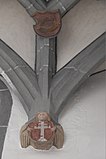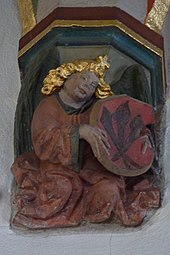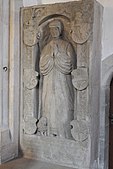City Church (Rosenfeld)
The Protestant town church in Rosenfeld , a town in the Zollernalb district in Baden-Württemberg , is a Gothic church building from the 14th or 15th century. The church was originally a Catholic branch church of the Isingen parish and consecrated to Our Lady . With the introduction of the Reformation in 1534, it became a Protestant parish church .
history
A chapel in Rosenfeld is mentioned for the first time in 1319 . The Church of Our Lady is mentioned for the first time in 1413. Towards the end of the 15th century the church was enlarged, the choir vaulted and the western vestibule, which is dated 1496, was added. In 1712 the tower got its octagonal structure. At that time, a flat ceiling was probably put in place in the choir instead of the vault, which was removed again during the renovation of the church between 1947 and 1955.
architecture
Choir tower
The square choir tower was originally covered with a tent roof, as a Merian engraving from 1643 proves. The year 1712, the date of its octagonal increase, is carved into the outer wall. Since then, it has been 34 meters high and is crowned by a curved hood with a lantern .
Portal porch
The two-story porch, also known as paradise , is covered by a pent roof and dates from the late Gothic period. The upper floor, on which the church archive was previously housed, is spanned by a ribbed vault with keystones . The Rosenfeld coat of arms is carved on one keystone and the year 1496 on the other. The lower floor has a ribbed vault , on the keystones of which the veil of the Veronica and the arms of the craftsmen (the shoemaker's guild and perhaps the butcher) are depicted. The consoles , on which the vault ribs rest, are decorated with angels and the tools of the Passion (cross, scourge and scourge column, crown of thorns and nails). In the middle, under the vault, a niche has been cut into the wall, which was probably intended for a figure of a saint. The niche is of one with finials occupied canopy crowned.
inner space
The single nave nave is covered by a flat wooden ceiling. In the 1950s, after the flat ceiling, which was probably drawn in in the 18th century, was removed, the rectangular choir was given a vault based on the Gothic style, which rests on iron girders and a structural steel net and whose ribs are made of stucco . The figurative consoles are, however, still preserved from the Gothic church building. On them angels and prophets are depicted with banners, coats of arms and also obscene scenes. The lead glass window in the choir was created by Paul Kälberer in 1961 . It is dedicated to the heavenly Jerusalem and shows above Christ in the mandorla surrounded by the evangelist symbols and below it angels with trumpets.
Murals
During the renovation of the church between 1985 and 1993, the gallery on the south side of the nave was removed and a window niche with wall paintings was discovered. The paintings are provided with an inscription that has not been fully preserved, from which the date of creation, the year 1645, and the presumed donor of the paintings, the mayor and saint- carer Jerg Harttenstein, can be found. The paintings representing the Damascus experience , the conversion of Saul the apostle Paul describe, is secco painting . The painting visible today was not carried out on fresh plaster, but on an already existing, earlier plaster layer on which a presumably Gothic painting has been applied. The exposed painting was preserved in its original state. To the right of this niche is another fragment of a wall painting depicting the sacrifice of Isaac .
Furnishing
- The year 1705 is carved on the baptismal font .
- The church has four bells, three of which were installed after the Second World War . The only bell that survived the war is marked with the year 1475. It is also the oldest piece of furniture in the church.
Tombstones
On the north wall of the choir, three tombstones are set into the wall.
- The gravestone of Cäcilia von Breitenlandenberg († 1551) had her brother-in-law Hans Konrad von Frauenberg, the Württemberg Vogt von Rosenfeld, put up. A niche with the reclining figure of the dead is recessed in the tombstone. A lion crouches at her feet and coats of arms are depicted on the sides.
- On the tombstone of Hans Konrad von Frauenberg (1547–1574) the year of his father's death is carved (“obiit pater 1531”), but his own is missing (“obiit filius ...”). The deceased is shown in his armor surrounded by coats of arms, his feet resting on a lion.
- The gravestone of Ernst von Frauenberg († 1612) has a large coat of arms and an inscription.
literature
- Erhard Lazi (Ed.): The Zollernalbkreis . Konrad Theiss Verlag , Stuttgart 1979, ISBN 3-8062-0205-2 , p. 172.
- City church Rosenfeld. Festschrift on the occasion of the renovation of the Rosenfeld town church. Inauguration of the new organ . Evangelical Church Community Rosenfeld (Ed.), Rosenfeld 1993.
Web links
- City Church Rosenfeld City of Rosenfeld
- Rosenfeld LEO-BW
Coordinates: 48 ° 17 '12.5 " N , 8 ° 43' 35.8" E














